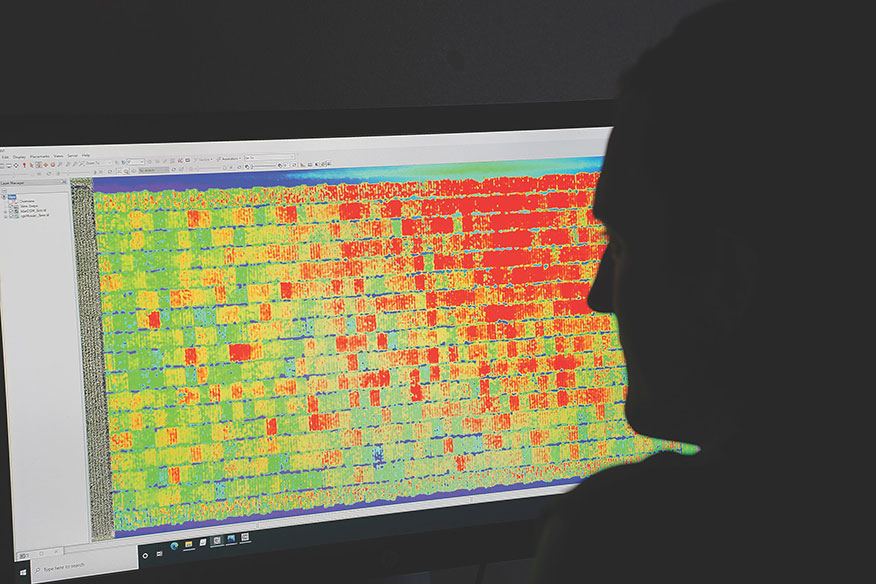Purdue technology provides site- and chemical-specific control of processes within live cells
Patent-pending real-time precision opto-control technology has applications in life sciences, biological and pharmaceutical research

Purdue University researcher Jesse Chi Zhang leads a team whose technology allows users to have site-specific and chemical-specific control of chemical processes within live cells. This laser-based approach has applications in biological and pharmaceutical research. (Purdue University photo/Steve Scherer)
WEST LAFAYETTE, Ind. —
Purdue University researchers in the College of Science have developed a patent-pending technology called RPOC, or real-time precision opto-control, which allows users to have site-specific and chemical-specific control of chemical processes within live cells.
Jesse Chi Zhang leads a team of researchers working on RPOC, which uses a laser-based approach to target and potentially manipulate cellular behavior.
“The imaging capability of our system has been compared to that of a commercial confocal fluorescence microscope, showing very similar results in resolution and imaging speed,” he said. “What sets it apart is its opto-control capability, a feature not offered by traditional confocal microscopes.”
The research has been published in peer-reviewed journals Nature Communications, Frontiers in Chemistry and Advanced Science. A recent development of software-assisted RPOC is self-archived in bioRxiv, an online service for unpublished research. Zhang is an assistant professor in Purdue’s James Tarpo Jr. and Margaret Tarpo Department of Chemistry and a faculty member in the Purdue Institute for Cancer Research and the Purdue Institute of Inflammation, Immunology and Infectious Disease.
Thomas Sors, director of scientific strategy and relations at the Purdue Institute of Inflammation, Immunology and Infectious Disease, said, “Jesse Chi Zhang’s technology has the potential to revolutionize drug discovery by manipulating chemical reactions inside cells at precise locations.”
A five-minute video about the technology is available on the Purdue Chemistry YouTube channel.
Purdue RPOC technology and its advantages
Zhang said the chemical processes within live cells are intricate and spatially diverse. Traditionally, chemical interventions are employed to regulate these processes.
“However, those chemicals introduced to cells have uncontrolled diffusion and can interact with multiple pathways, potentially leading to off-target effects,” he said. “Before the development of our technology, no method existed to precisely control where, when and how chemical processes occur within cells.”
Zhang said RPOC uses a laser-based approach rather than general chemical interventions to control chemical processes.
“A scanning excitation laser is directed onto the sample,” he said. “Upon detecting a chemical target, the optical signals from the target rapidly activate other action lasers, which can precisely control the chemical processes exclusively at the targeted locations.
“This method enables selective activation of a drug only at specific locations, perturbing the functions of particular organelles or erasing specific molecules of interest,” he said.
Zhang said no other existing technologies offer the same functionality as RPOC.
“RPOC provides users with real-time feedback, simultaneous treatment and imaging capabilities, and never-before-seen precision in optical manipulation,” he said. “The target selection process is chemically specific and automatic, relying on optical signals from the sample. Additionally, a recently developed human-machine interaction system has introduced unparalleled freedom and precision to the target selection process. Furthermore, RPOC enables simultaneous control of multiple lasers and facilitates precise treatment of mobile targets.”

Zhang said other technologies like confocal fluorescence microscopes are related to RPOC but have drawbacks.
“They lack real-time treatment and imaging capabilities and are unsuitable for controlling mobile targets,” he said. “Confocal fluorescence microscopes are predominantly designed for imaging purposes rather than optical control, and they cost approximately $300,000.”
Life science and pharmaceutical applications
RPOC’s initial applications are within the life sciences, namely fundamental biological research.
“For instance, we aim to elucidate how specific chemicals impact cellular behavior and responses,” Zhang said. “This approach enables us to discern the connections between functions of perturbed molecules and cellular responses.”
Zhang said RPOC also exhibits considerable potential for pharmaceutical research because it can facilitate the elucidation of site-specific drug functions within cells or animals.
“We are actively exploring using RPOC to regulate cell division, embryo development and cancer cell migration by precisely uncaging or activating compounds at desired subcellular sites,” he said. “This pursuit holds promise for the development of novel methodologies to manipulate cellular behaviors and cell fate.”
Zhang disclosed RPOC and other related innovations to the Purdue Innovates Office of Technology Commercialization, which has applied for patents to protect the intellectual property.
Zhang and his team have received financial support for their research through a multimillion-dollar, multiyear grant through the Maximizing Investigators’ Research Award from the National Institute of General Medical Sciences.
Zhang said, “Our development would not have been possible without the support of the staff engineers and scientists at the Jonathan Amy Facility for Chemical Instrumentation, especially R. Michael Everly, Mark Carlsen and Gregory Eakins.”
About Purdue Innovates Office of Technology Commercialization
The Purdue Innovates Office of Technology Commercialization operates one of the most comprehensive technology transfer programs among leading research universities in the U.S. Services provided by this office support the economic development initiatives of Purdue University and benefit the university’s academic activities through commercializing, licensing and protecting Purdue intellectual property. In fiscal year 2023, the office reported 150 deals finalized with 203 technologies signed, 400 disclosures received and 218 issued U.S. patents. The office is managed by the Purdue Research Foundation, which received the 2019 Innovation & Economic Prosperity Universities Award for Place from the Association of Public and Land-grant Universities. In 2020, IPWatchdog Institute ranked Purdue third nationally in startup creation and in the top 20 for patents. The Purdue Research Foundation is a private, nonprofit foundation created to advance the mission of Purdue University. Contact otcip@prf.org for more information.
About Purdue University
Purdue University is a public research institution demonstrating excellence at scale. Ranked among top 10 public universities and with two colleges in the top four in the United States, Purdue discovers and disseminates knowledge with a quality and at a scale second to none. More than 105,000 students study at Purdue across modalities and locations, including nearly 50,000 in person on the West Lafayette campus. Committed to affordability and accessibility, Purdue’s main campus has frozen tuition 13 years in a row. See how Purdue never stops in the persistent pursuit of the next giant leap — including its first comprehensive urban campus in Indianapolis, the Mitchell E. Daniels, Jr. School of Business, Purdue Computes and the One Health initiative — at https://www.purdue.edu/president/strategic-initiatives.
Writer/Media contact: Steve Martin, sgmartin@prf.org
Source: Jesse Chi Zhang, zhan2017@purdue.edu



